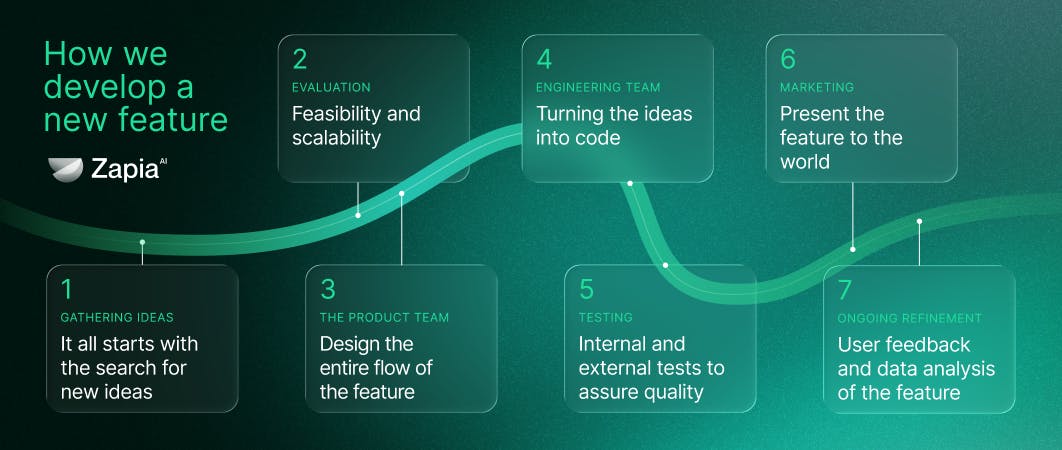Back to blog
September 10th, 2025
How we develop new features at Zapia AI
At Zapia, we’re always looking for new ways to improve our users' experience and offer innovative solutions. The process of creating a new feature is a collaborative and strategic journey that involves several stages to ensure that when we launch something new, it truly adds value to our audience.Have you ever wondered what the process looks like from the idea to it becoming a tool on your WhatsApp? Let me explain.

1. Gathering Ideas
It all starts with the constant search for new ideas. These can come from various sources:- Users: Many ideas come directly from the people who use our platform. Feedback and suggestions are always a valuable source we love to base ourselves on.
- References and Inspirations: The world is constantly evolving, and new trends emerge all the time. We observe what's happening in the market, learn from what other companies are doing, and adapt those ideas to the Zapia context, especially when it comes to virtual assistants for automating tasks on WhatsApp.
- Internal Ideas: The Zapia team also suggests great ideas. They know the platform inside out and have a unique perspective on both internal needs and the market.
2. Feasibility and Scalability Evaluation
Once we have the ideas, the next step is to assess whether the feature is feasible. This involves considering whether it can be technically implemented and whether we have the resources to develop it.Scalability is also a crucial factor. We ask ourselves: “Will many users truly find value in this feature?” This kind of analysis is key in digital product development with artificial intelligence, as we aim to ensure that a new feature can be used by a large portion of our user base.
3. Lab Phase: The Product Team
Once the idea is approved, it moves to the lab phase. The product team is responsible for designing the entire flow of the feature. Here, we define several key aspects, such as:- Mechanics: How will the feature be presented to users? We need to ensure that it aligns with Zapia's tone and identity and that is easy to use.
- Possible Variations: There are different ways a user can start an interaction with AI, and it’s our job to identify the key triggers to activate the new feature, as seen in the process of creating an app with AI.
- Problem to Solve: The core idea is always to solve a real problem for our users. That’s why every example of user experience improvement with AI guides us in building solutions that truly deliver value.
4. Engineering Team: Development
Once the flow and details are defined, the engineering team takes action. They are responsible for turning the ideas into code, and the code into a response from Zapia to the user. This phase involves development, integration testing, and adapting the platform to efficiently support the new feature.The engineering team needs to ensure that the feature is stable, fast, and secure for everyone. This is how we demonstrate how to develop a digital feature from scratch, ready to scale to millions of users.
5. Testing: Ensuring Quality
After development, the feature enters the testing phase, which is broken down into several stages to ensure everything works as expected:- Phase 1 - Internal Testing: First, we test internally within the Zapia team. They are the first to spot errors and provide valuable feedback.
- Phase 2 - Friends and Family: After internal tests, the feature is released to a select group of friends and family of our team members, ensuring feedback from people not directly involved in the project.
- Phase 3 - Community Testers: The next phase involves our community of beta testers for new WhatsApp features, composed of users who sign up to test new functionalities. They provide crucial insights to refine the feature before the official launch.
- Phase 4 - Launch for All: After fixing all critical bugs, the feature is released to all Zapia users.
6. Marketing Launch: Time to Share
With the feature ready and tested, it’s time to present it to the world. The marketing team steps in, creating campaigns to announce the launch on social media, in newspapers, and frequently, through influencers. This step ensures that the maximum number of users discovers and benefits from the new feature.7. Continuous Improvement: Ongoing Refinement
The process doesn’t stop with the launch. At Zapia, we believe in continuous improvement. We listen to user feedback and analyze usage data to refine the feature. This philosophy of continuous improvement in virtual assistants with AI ensures that we are always evolving and responding to the real needs of our users.🚀 From Idea to Everyday Use: How the Reminders Feature Was Born
The Reminders feature at Zapia started within our team, who wanted to provide an easy and quick way to schedule tasks on WhatsApp with AI. We created and tested the first version following the same process we use for all features until we launched it for our users.Later, we listened to our users, who asked for the option of recurring reminders, a perfect idea for routines such as taking medication at the same time every day or watering plants every morning. We took the feedback into account, went through the development cycle again, and today that improvement is available to everyone, making the tool even more useful and powerful.
